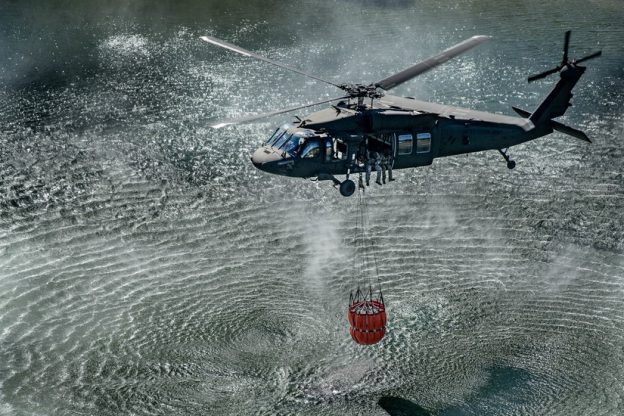There are times that government statements reveal more in what they do not say than in what they do discuss.
Though the United States has yet to experience a complex catastrophe in which millions of people are displaced, killed or injured, the Defense Department and other agencies have to be ready to respond should a catastrophic event occur.
Deputy Assistant Secretary of Defense for homeland defense Robert G. Salesses laid out some possible catastrophic scenarios, while addressing a United States Army panel on Preparedness for a Complex Catastrophe. He noted several scenarios:
- The New Madrid Fault along the Mississippi River in Missouri and Arkansas could produce a massive earthquake, as it did in the early 19th century, when very few people lived in the area.
- The Cascadia Subduction Zone on the West Coast could experience a massive earthquake, as it did in the early 18th century.
- A weapons-of-mass destruction attack.
Noticeably missing from the list was the threat of an electromagnetic pulse, or “EMP.” Whether from natural causes, such as solar activity, or from an enemy attack, (Russia, China, and North Korea are known to have EMP capabilities) an EMP event could destroy all electronics within the United States.
Under the Defense Support of Civil Authorities authorization, the Defense Department would contribute in a massive way to rescue, relief and recovery efforts in a complex catastrophe, he said.
Although all of the service branches could be involved, some of the commands and agencies spearheading the effort would be the Defense Logistics Agency, U.S. Transportation Command and the Army Corps of Engineers. In addition, the U.S. Northern Command would synchronize efforts in North America, and the U.S. Indo-Pacific Command would do the same for Hawaii and U.S. territories in the Pacific, Salesses said.
Installations themselves could also be huge providers of transportation, logistics and personnel, he added.
The response, however, would not be DOD’s alone, he emphasized. DOD would need to be part of a unified effort within the government.
One of the most important agencies that the department has worked with is the Federal Emergency Management Agency, Salesses said. FEMA has taken the lead in past emergencies, with DOD taking a supporting role.
The departments of Energy, Transportation and Health and Human Services would also be involved, he said. DHHS would activate its Public Health Service doctors and providers, but in a complex catastrophe, DOD’s medical personnel and assets would be deployed along with them.
Salesses said state and local governments would contribute assets along with the National Guard and the private sector.
A unified effort, he said, would include a coordinated assessment of the impacts of the disaster and competing priorities. Command and control would need to be established, and capabilities and requirements would need to be identified and allocated.
To prepare for such a complex undertaking, DOD has been building and sustaining partnerships and relationships with federal, state and local agencies, Salesses said, and exercises are periodically held to test the coordination and response.
Operations in response to hurricanes, wildfires and flooding also provide a test of that effort, but the effort would need to be scaled way up in a complex catastrophe, Salesses said.
But EMP preparation was missing fron Salesses discussion. As the New York Analysis of Policy and Government previously reported, In 2017 testimony to Congress about the imminent threat of an EMP attack on the United States by Dr. William R. Graham, Chairman, and Dr. Peter Vincent Pry, chief of staff, of the Commission to Assess the Threat to America from Electromagnetic Pulse (EMP), the two experts noted:
“In the event of a nuclear EMP attack on the United States, a widespread protracted blackout is inevitable.” According to their report, “The damage level could be sufficient to be catastrophic to the Nation, and our current vulnerability invites attack…
“We highly commend President Trump’s new Executive Order “Strengthening the Cybersecurity of Federal Networks and Critical Infrastructure” signed on May 11, 2017. We strongly recommend that implementation of cybersecurity for the electric grid and other critical infrastructures include EMP protection, since all-out cyber warfare as planned by Russia, China, North Korea, and Iran includes nuclear EMP attack. However, current institutional arrangements for protecting and improving the reliability of the electric grids and other critical infrastructures through the U.S. FERC and the NERC are not designed to address major national security threats to the electric power grids and other national critical infrastructures. Using FERC and NERC to achieve this level of national security is beyond the purpose for which those organizations were created and has proven to be fundamentally unworkable. New institutional arrangements are needed to advance preparedness to survive EMP and related threats to our critical national infrastructures.”
It’s unknown whether Salesses intentionally ignored EMP threats to not highlight an issue that could cause deep public concern, whether he simply assumes that an EMP attack comes under a “Weapons of Mass Destruction” category, or whether the Pentagon prefers to keep the preparations, as urged by the Trump White House, out of the public’s view. As of this writing, there is no indication that substantial EMP precautions have yet been implemented.
Photo: Preparing for catastrophe (U.S. Army)
